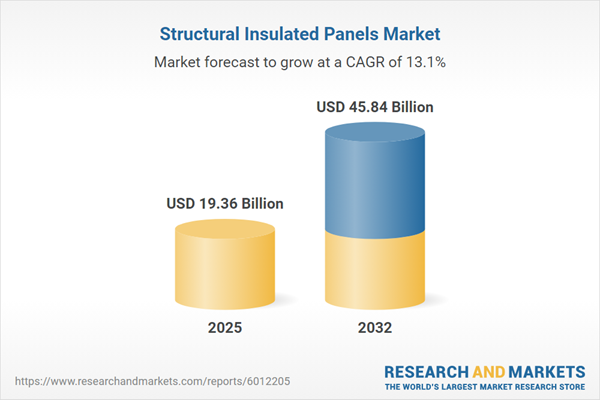Speak directly to the analyst to clarify any post sales queries you may have.
Structural insulated panels are gaining prominence among senior construction leaders as an effective solution for navigating emerging regulatory, sustainability, and operational requirements. As the construction sector adapts to evolving demands, these panels are integral to future-ready building strategies and efficient project delivery.
Market Snapshot: Structural Insulated Panels Market Growth
The global structural insulated panels market is demonstrating steady growth, with the market expected to expand from USD 17.07 billion in 2024 to USD 19.36 billion in 2025, reflecting a compound annual growth rate of 13.14%. Looking ahead, market size estimations reach USD 45.84 billion by 2032.
Several factors are driving this progress, including advancements in insulation technology, greater enforcement of energy efficiency standards, and harmonization with international building codes. Leading market players are innovating with advanced panel solutions, emphasizing reliability and regulatory compliance across a variety of regional contexts and complex project specifications.Scope & Segmentation: Structural Insulated Panels Market
- Product Types: Floor panels, roof panels, and wall panels are designed for superior thermal efficiency and structural strength, spanning use in commercial, industrial, and residential construction from initial planning through project completion.
- Resin Types: Expanded polystyrene, polyisocyanurate, and polyurethane cores serve critical roles, each tailored for application-specific insulation demands, durability, and alignment with best-practice building codes.
- End Users: Commercial developers, industrial facility operators, and residential builders increasingly adopt these panels for both new developments and retrofit projects, responding to escalating demand for resilient and efficient building materials.
- Distribution Channels: Offline wholesalers, specialist distributors, and digital procurement platforms support diverse sourcing needs and match logistics solutions with varied construction timelines and operational requirements.
- Regions Covered: Americas, Europe, Middle East & Africa, and Asia-Pacific, where adoption trends reflect local regulation landscapes, regional infrastructure investments, and policy priorities guiding construction innovation.
- Key Companies Profiled: Kingspan Group, Owens Corning Corporation, Isopan S.p.A., Alubel S.p.A., CBG Building Systems, Hunter Panels (Carlisle Companies), Thermocore, Premier Building Systems, Viriform Building Products, and Insulspan (PFB Corporation) shape market evolution through technology development and customized solutions for different market needs.
Key Takeaways for Senior Decision-Makers
- Structural insulated panels support organizations in meeting rising sustainability targets and adapting to both local and global building standards efficiently.
- Prefabricated and offsite manufacturing approaches streamline construction processes, decrease onsite labor intensity, and shorten overall build schedules.
- Digital management platforms, including building information modeling, enhance project oversight, risk mitigation, and cost control across complex workflows.
- Material innovations increase the adaptability of panel solutions, ensuring readiness for rapidly changing regulatory or environmental requirements in different regions.
- Procurement and sourcing strategies now account for region-specific factors such as policy shifts in Europe, growth investments in Asia-Pacific, and redevelopment in the Americas, driving targeted decision-making.
- Supply chain resilience improves through diversified sourcing and collaborative supplier relationships, equipping stakeholders to manage volatility from global trade or policy changes.
Tariff Impact: United States 2025 Supply Chain Dynamics
Recent tariffs in the United States on imported foam core and resin materials are reshaping procurement strategies, accelerating both domestic manufacturing investments and in-country fabrication. This shift helps stabilize pricing and supports more reliable supply chains. Senior decision-makers are prioritizing partnerships with local suppliers and refining risk management protocols to anticipate and address disruptions linked to evolving trade and tariff landscapes.
Methodology & Data Sources
This report draws from interviews with senior industry executives, detailed technical analyses, and benchmarking against trusted sources. The recommendations are grounded in validated findings to inform procurement and strategic planning in construction materials.
Why This Report Matters
- Enables executive teams to refine procurement, project management, and risk mitigation tactics aligned with shifting regulations and industry advances.
- Provides an evidence-based foundation for supplier performance evaluation, driving ongoing improvements in project efficiency and value.
- Delivers actionable guidance on digital transformation and compliance to support consistent workflows and defend competitive positioning.
Conclusion
As building standards and practices evolve, structural insulated panels deliver meaningful advancements in efficiency, compliance, and project success. The insights in this report equip leaders to strengthen sourcing, management, and execution strategies in increasingly dynamic construction environments.
Additional Product Information:
- Purchase of this report includes 1 year online access with quarterly updates.
- This report can be updated on request. Please contact our Customer Experience team using the Ask a Question widget on our website.
Table of Contents
3. Executive Summary
4. Market Overview
7. Cumulative Impact of Artificial Intelligence 2025
Companies Mentioned
The companies profiled in this Structural Insulated Panels market report include:- Kingspan Group
- Owens Corning Corporation
- Isopan S.p.A.
- Alubel S.p.A.
- CBG Building Systems, Inc.
- Hunter Panels by Carlisle Companies Incorporated
- Thermocore, Inc.
- Premier Building Systems
- Viriform Building Products Ltd
- Insulspan by PFB Corporation
Table Information
| Report Attribute | Details |
|---|---|
| No. of Pages | 196 |
| Published | October 2025 |
| Forecast Period | 2025 - 2032 |
| Estimated Market Value ( USD | $ 19.36 Billion |
| Forecasted Market Value ( USD | $ 45.84 Billion |
| Compound Annual Growth Rate | 13.1% |
| Regions Covered | Global |
| No. of Companies Mentioned | 11 |









